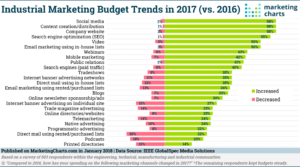How to Create a Lasting Brand Experience
“When they are well-crafted, brand experiences inspire new thinking, connect people in meaningful ways, move audiences to take action like no other medium, and, as a result, they deliver results. At the end of the day, the measure of any medium is its ability to move your audience farther and faster, and brand experiences do that in a really compelling way.” Chris Cavanaugh, CMO at Freeman

In today’s highly competitive and rapidly changing market, building a positive brand experience can help your business stand out. Let’s have a look at the numbers.
- According to a study by Nielson, 59 percent of consumers prefer to purchase new products from brands that are familiar to them.
- Research, Rising Expectations in Consumer Brand Experiences, revealed that 61 percent of people expect brands to tailor experiences according to their preferences.
- A survey conducted by PWC revealed that 73 percent of consumers mentioned that a good experience is critical in influencing their brand loyalties.
This shows that the consumers of today value brand experiences more than products and expect these experiences to communicate with them in a personalized manner.
But first, let’s start with the basics. What is the brand experience? Brand experience is a form of experiential marketing, which involves designing a lasting experience for building long-term and meaningful relationships with the target audience.
Are you a startup? Not sure how to get started? Here are the 6 simple steps that can help you create a successful brand experience:
Step #1 Identify What Your Brand Represents
Start off by listing down the strengths of your business and assess why your business was created in the first place. One of the best ways is to formulate a mission statement that clearly tells the purpose of the brand.
Other than this, an effectively written mission statement will also ensure that all your strategies, products, and brand actions are in sync, thus providing a compelling brand experience to your customers.
Unsure how a good mission statement should look like? Let’s take the example of Honest Tea as its mission statement visibly states its brand values, product benefits, and quality.

Step #2 Set Your Brand Apart From the Competition
It is an undeniable fact that small businesses or newly-built startups can gain competitive advantages by implementing product and brand differentiation strategies.
Below are a few tips that can help keep your brand distinct from your competitors:
- Conduct thorough competitor research to identify the areas for differentiation that you can tap.
- Create a unique positioning for your brand to attract your audience and resonate with them.
- Provide a world-class customer experience for gaining customer delight.
- Identify and nurture brand advocates to facilitate positive word-of-mouth.
- Pay attention to social listening and monitoring for gathering customer feedback.
- Create a great logo. Check out this Logo Maker to get started.
Therefore, if you’re looking to win your brand differentiation game, and face competition firmly, give the tips mentioned above a shot.
Step #3 Know Your Audience
It is no surprise that every marketing effort starts by determining the target audience first. This is because your brand can’t be everything to everyone, so it is critical to keep in mind who you are planning to target.
For example, if you’re marketing daycare services, instead of ‘All the mothers’, you could narrow your reach to ‘Single mothers who work full-time.’
Step #4 Focus on a Human-Centered Experience
Once you’ve known your target audience, the next step is to get in their shoe, and design the customer journey to meet their needs, wants, and preferences.
According to a study, 44 percent of consumers stated that they are more likely to become repeat buyers after a personalized shopping experience with a particular company. Thus, for successful branding, it is very crucial to personalize your marketing offers by adding the human element to them.
The marketing environment has immensely changed and brands are turning to social media more and more but it is crucial to remember that real-life experiences still matter and will do for a very long time. People tend to remember the positive and original interactions with the brand which can only be reached by offline marketing. There are many ways out there to promote your brand in front of your customer. Mobile marketing tours can be ideal when you want to drive big brand awareness and put stress on humanized experience. The options are always open, it is coming up with the right one for your brand that is important.
Don’t know how to go about it? Here’s what the famous chocolate manufacturer, Cadbury did. A campaign was introduced in which Cadbury collected data from people’s profiles and created personalized videos for them, containing their pictures, and other information.
After the implementation of this video, Cadbury didn’t just succeed in touching the hearts of its audience, but this video also resulted in a 65 percent click-through rate, and a 33.6 percent conversion rate.
Step #5 Leverage Digital Marketing
By now we know, that digital marketing has become an indispensable part of business marketing, primarily because of its ability to reach out to a global market place.
According to Marketing Charts, digital marketing budgets have increased by 50 percent compared to 2016.

If you’re looking to improve your marketing ROI, start working on your digital marketing strategy today. This is because:
- Your potential customers are online.
- Digital marketing channels allow you to be accessible to your target audience.
- You can engage with your prospects online and look at their needs and preferences closely.
- Most of the digital marketing avenues offer effective targeting options to reach out to the relevant audience.
Step #6 Be Professional
It is a known fact that professionalism is crucial for the long term success of a business, whether big or small. But the real question is, how do you depict a professional image of your business in front of your audience?
The simplest way is by making sure that all your marketing efforts or assets, such as your website or logo design are created effectively, and should reflect your brand values.
Although the logo serves as the face of your brand and is an essential component of all your marketing collaterals, yet it is often seen that small or newly established businesses do not pay much attention to their logo designs. Due to this, they fail to exhibit a professional brand image.
So, if you’re looking to create an impact, it is best to hire a professional logo design company, as people tend to associate well-designed logos with first-class services provided by your business.
Once you have your perfect logo designed using a logo maker, it’s time to introduce it to your audience. Your logo is often the strongest visual representation of your brand because it is associated with all the activities and ideas of your company. As such, you want to make sure that your logo is as visible as possible throughout every marketing platform and item available. A website should display this logo prominently in addition to everything from letterheads and digital business cards, to in-person marketing events and campaigns. When taking part in events and campaigns, be sure to give care and attention when representing yourself so that everyone knows who is present — for example, a tent personalized with a stand-out image of your logo by using inflatables with fantastic logos. Not only does a custom inflatable logo bring an instant feeling of excitement and professionalism to the event itself, but it also serves as a beacon of visibility for passing traffic. Its sheer size and vibrant colors make it hard to miss, even from far away. This will guarantee that everyone knows who spoke at the conference, attended a meeting, or planned an incredible company party. Logos are powerful symbols: make yours one which stands out amongst the rest.
How To Create a Logo With AI

Creating a logo with AI in 2025 is not only feasible but also remarkably efficient. AI-powered tools have democratized design, enabling anyone—from budding entrepreneurs to seasoned marketers—to craft professional logos without the need for extensive design skills. Let’s delve into how you can harness AI to design a compelling logo for your brand.
Why Opt for AI in Logo Design?
AI-driven logo design tools offer several advantages:
-
Speed and Efficiency: Generate multiple logo concepts in minutes.
-
Cost-Effective: Eliminate the need for hiring expensive designers.
-
Customization: Tailor designs to align with your brand’s identity.
-
User-Friendly: No prior design experience required.
Step-by-Step Guide to Creating a Logo with AI
1. Define Your Brand Identity
Before diving into design, clarify your brand’s:
-
Name: The exact text to appear on the logo.
-
Industry: Helps in selecting relevant symbols and styles.
-
Values and Mission: Guides the overall tone and feel.
-
Color Preferences: Colors evoke specific emotions and associations.
-
Font Styles: Choose between modern, classic, playful, etc.
2. Choose an AI Logo Maker
Several AI-powered tools can assist you:
-
Looka: Offers a seamless experience with extensive customization options.
-
Canva: Provides a vast library of templates and an intuitive interface.
-
Logo Diffusion: Allows for text-to-logo generation with high-quality outputs.
-
Microsoft Designer: Integrates AI to generate logos based on your prompts.
3. Input Your Brand Details
Enter your brand name, select your industry, and specify your design preferences. The AI will generate a variety of logo concepts tailored to your inputs.
4. Customize Your Logo
Refine the AI-generated logos by adjusting:
-
Colors: Ensure they align with your brand palette.
-
Fonts: Select typography that reflects your brand’s personality.
-
Icons and Symbols: Choose visuals that resonate with your brand message.
-
Layout: Modify the arrangement for optimal balance and aesthetics.
5. Download and Use
Once satisfied, download your logo in various formats (e.g., PNG, SVG, PDF) suitable for different applications like websites, business cards, and merchandise.
Tips for an Effective AI-Generated Logo
-
Simplicity is Key: A clean design ensures versatility and recognizability.
-
Scalability: Ensure the logo looks good both in small and large sizes.
-
Relevance: The design should reflect your brand’s essence and industry.
-
Originality: While AI provides templates, infuse unique elements to stand out.
AI has revolutionized the logo design process, making it accessible and efficient. By leveraging these tools, you can craft a logo that encapsulates your brand’s identity and appeals to your target audience. Embrace the fusion of technology and creativity to establish a memorable brand presence.
The Bottom Line
All said and done, it is important to remember that you cannot create a lasting brand experience for your audience overnight. Be patient, as everything takes time.
However, consistently applying the steps mentioned above will allow you to provide an impactful brand experience for long-term success and building deeper connections with the audience.
FAQ
What is brand experience, and why is it important for businesses?
Brand experience encompasses all interactions and touchpoints a customer has with a brand. It’s vital for businesses as it shapes perceptions, loyalty, and ultimately, success.
How does brand experience differ from branding or brand identity?
Brand experience goes beyond visual elements like logos and colors. It encompasses the entire customer journey, including product quality, customer service, and marketing.
What role does customer satisfaction play in creating a positive brand experience?
Customer satisfaction is a key component of a positive brand experience. Happy customers are more likely to become loyal advocates for a brand.
How can businesses ensure a consistent brand experience across various touchpoints?
Consistency can be achieved through clear brand guidelines, employee training, and regular monitoring of customer interactions.
What is the connection between brand values and brand experience?
Brand values should guide every aspect of a brand’s actions and interactions, ensuring alignment with customer expectations.
How can online businesses create a memorable brand experience in a digital environment?
Online businesses can create memorable experiences by offering user-friendly websites, personalized content, excellent customer support, and seamless transactions.
What are some examples of brands known for delivering exceptional brand experiences?
Brands like Apple, Disney, and Amazon are often cited for their exceptional brand experiences, characterized by innovation, personalization, and customer-centricity.
How can social media and digital marketing contribute to shaping a brand experience?
Social media and digital marketing allow brands to engage with customers in real-time, share their values, and create emotional connections.
What are the steps to measure and analyze the effectiveness of a brand experience strategy?
Measurement involves tracking customer satisfaction, net promoter scores, and analyzing customer feedback to make data-driven improvements.
Why is it crucial for brands to adapt and evolve their brand experience strategies over time?
Adaptation and evolution are essential as customer expectations change, and market dynamics shift. Brands must remain relevant and meet evolving needs to maintain a positive brand experience.
How can storytelling enhance a brand’s overall experience for customers?
Storytelling helps brands connect with customers on an emotional level, creating a memorable and relatable brand experience.
What is the role of employee training and alignment in delivering a consistent brand experience?
Employees play a crucial role in delivering the brand experience. Training ensures they understand and embody the brand’s values and promise.
How does a positive brand experience contribute to customer loyalty and brand advocacy?
Positive brand experiences foster loyalty, and satisfied customers are more likely to become advocates, promoting the brand to others.
What are some strategies for personalizing the brand experience for individual customers?
Personalization involves analyzing customer data to tailor marketing messages, recommendations, and interactions to each customer’s preferences.
How can brands recover from a negative customer experience and turn it into a positive one?
Brands can recover by acknowledging mistakes, providing solutions, and going the extra mile to exceed customer expectations in subsequent interactions.
What is the role of community and user-generated content in shaping a brand’s online experience?
Community engagement and user-generated content create a sense of belonging and authenticity, enhancing the online brand experience.
How do cultural and regional differences impact the design of a brand experience strategy for global brands?
Cultural and regional differences necessitate adaptation to local customs, values, and preferences in order to resonate with diverse audiences.
How can brands effectively communicate their core values as part of the brand experience?
Brands can communicate core values through mission statements, marketing campaigns, corporate social responsibility initiatives, and consistent actions.
What are the ethical considerations in creating a brand experience, especially in relation to data privacy and transparency?
Ethical considerations involve respecting customer privacy, transparent data practices, and ensuring that the brand’s values align with ethical standards.
What is the future outlook for brand experience in an increasingly digital and interconnected world?
The future of brand experience will likely involve deeper personalization, immersive technologies like virtual reality, and continued emphasis on sustainability and ethical practices to meet evolving customer expectations.
How does brand experience contribute to a brand’s differentiation in a competitive market?
Brand experience sets a brand apart by creating unique, memorable interactions that competitors find challenging to replicate.
What are the key elements of a successful brand experience strategy?
Successful brand experience strategies encompass brand consistency, customer-centricity, authenticity, emotional connection, and innovation.
How can brands leverage customer feedback and insights to improve their brand experience?
Customer feedback and insights provide valuable information for identifying pain points, refining strategies, and continuously enhancing the brand experience.
What is the role of customer journey mapping in understanding and optimizing the brand experience?
Customer journey mapping helps visualize and analyze every touchpoint a customer has with the brand, allowing for targeted improvements.
What is the impact of a positive brand experience on customer retention and recurring business?
Positive brand experiences lead to higher customer retention rates, repeat purchases, and increased customer lifetime value.
How can brands build trust and credibility as part of the brand experience?
Trust and credibility are built through consistent delivery of promises, transparency, reliable products or services, and ethical practices.
What strategies can brick-and-mortar businesses employ to create a compelling in-store brand experience?
In-store brand experiences can be enhanced through store design, visual merchandising, knowledgeable staff, and immersive customer interactions.
How do B2B brands approach brand experience differently from B2C brands?
B2B brands focus on building long-term relationships, providing value-driven solutions, and delivering seamless, efficient experiences tailored to business needs.
What are some examples of successful rebranding efforts aimed at improving the overall brand experience?
Examples include Airbnb’s rebranding to emphasize community, and Starbucks’ initiatives to enhance its customer experience through store redesigns and digital innovations.
How can small businesses and startups create impactful brand experiences on a limited budget?
Small businesses can focus on personalized customer interactions, authentic storytelling, and leveraging social media to create meaningful brand experiences that resonate with their target audience.
Create more and better content
Check out the following resources and Grow!